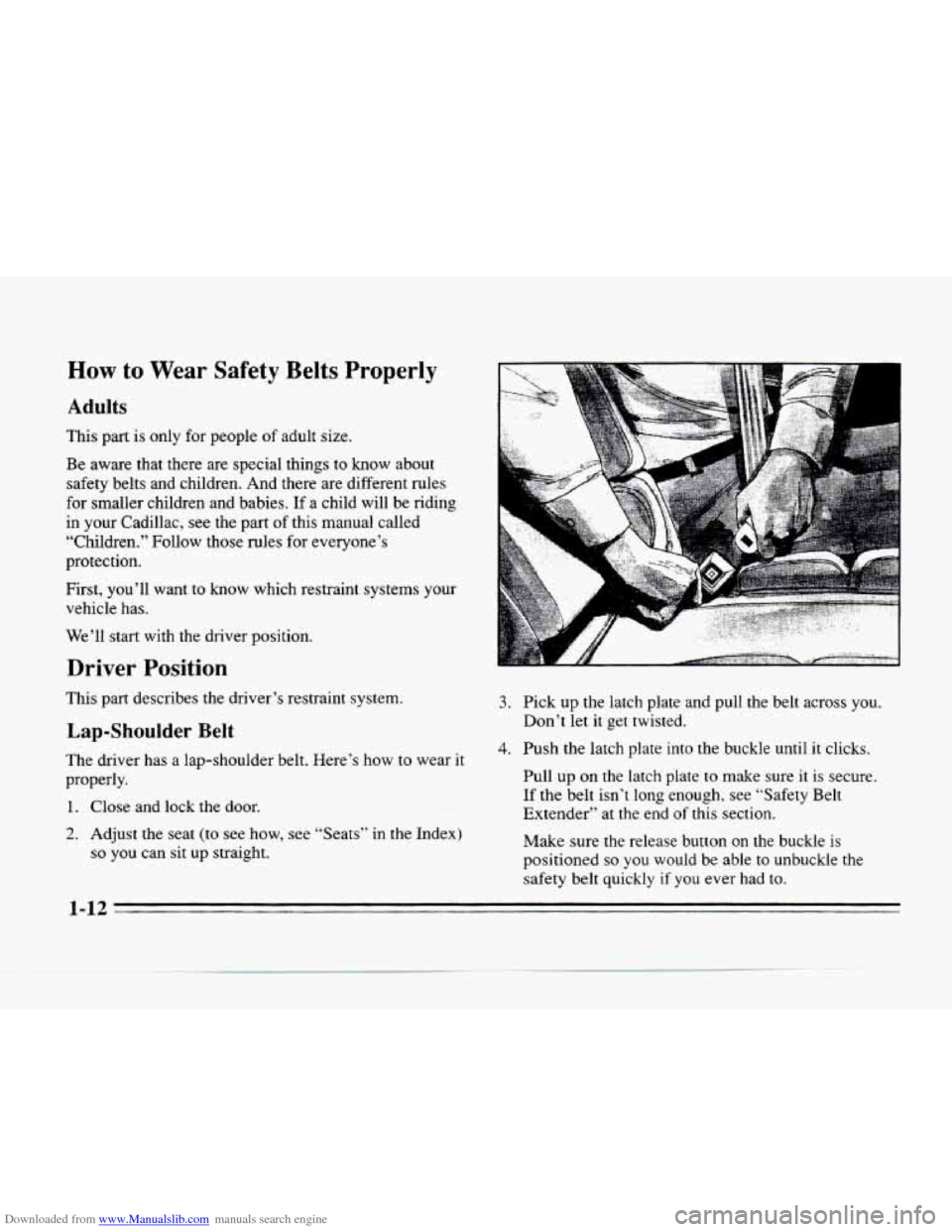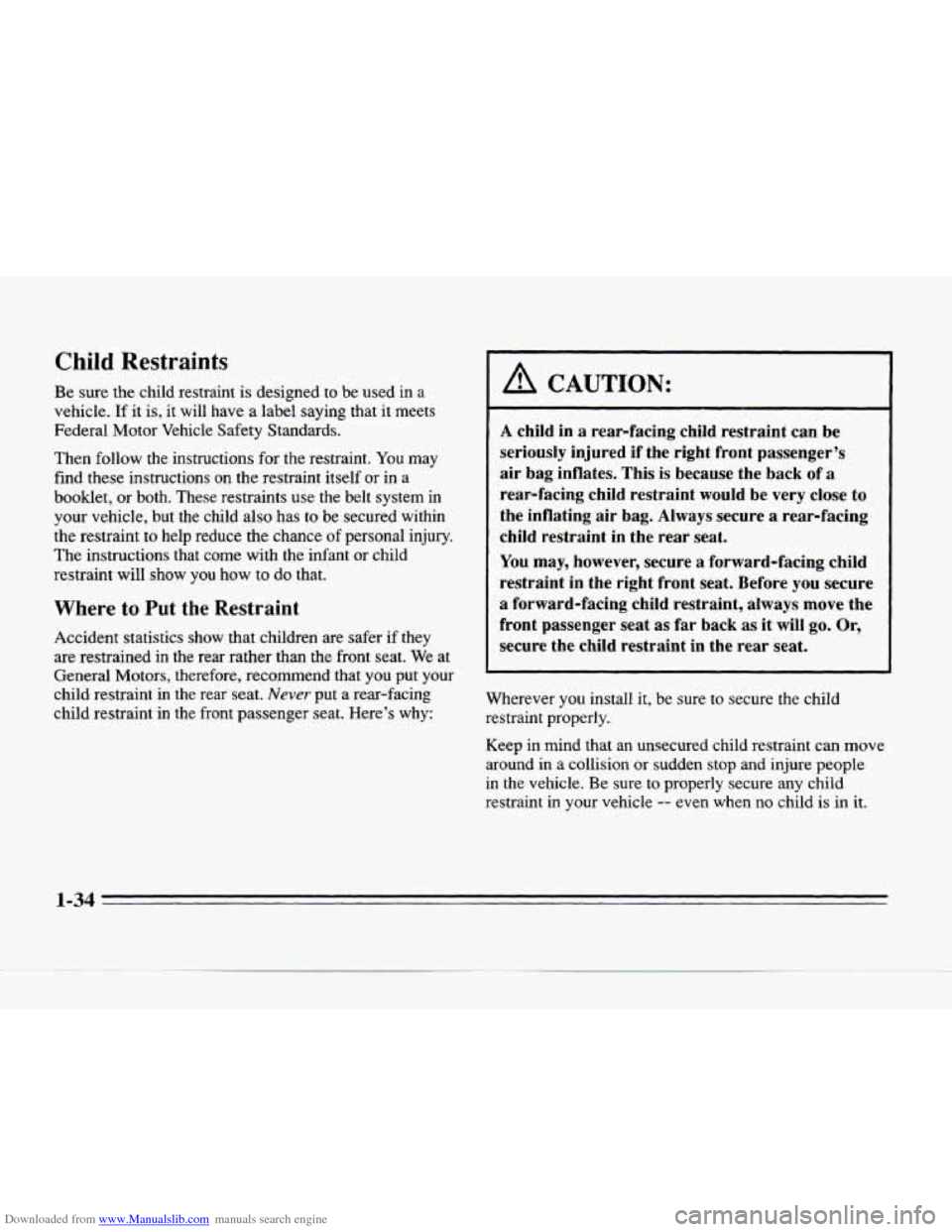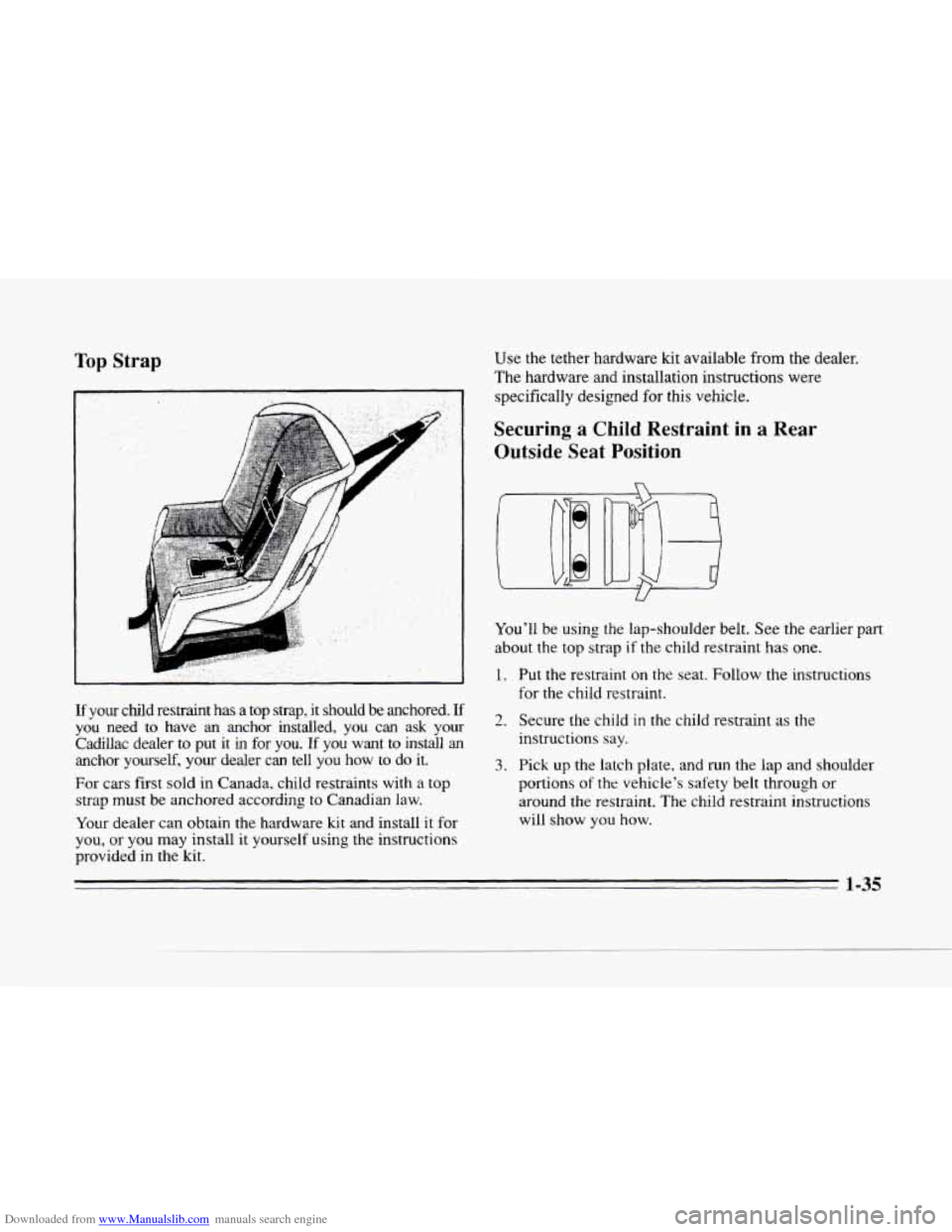Page 8 of 354

Downloaded from www.Manualslib.com manuals search engine L.
Iy
finest documents ever written. It was published following
the introduction
of the first production V8 engine, which
was standard in all Cadillacs beginning with the 191 5
model. Many Cadillac "firsts" have followed
over the years,
including the synchro-mech clashless transmission. a
nationwide comprehensive service policy, security plate
glass, chrome plating and the first car to be designed by
a stylist
(1927 LaSalle/Harley Earl). The '30s witnessed
production
of the powerful, smooth and quiet V12 and
V16 engines. The crisp, contemporary lines of the 1938
60 Special series ushered in a new era in styling.
4
VI4 Engine
During World War 11, shortly after Pearl Harbor,
Cadillac discontinued car production for
the first time
since 1902 in order to construct light tanks, combat
vehicles and internal
parts for Allison V17 10 engines.
Two Cadillac V8 engines and Hydra-Matic
transmissions were used
in each MSAI and M24 tanks.
1931 VI4 Sport Phaeton
vii
Page 27 of 354

Downloaded from www.Manualslib.com manuals search engine How to Wear Safety Belts Properly
Adults
This part is only for people of adult size.
Be aware that there are special things to
know about
safety belts and children. And there are different rules
for smaller children and babies. If a child will be riding
in your Cadillac, see the part of this manual called
“Children.” Follow those rules for everyone’s
protection.
First, you’ll want
to know which restraint systems your
vehicle has.
We’ll start with the driver position.
Driver Position
This part describes the driver’s restraint system.
Lap-Shoulder Belt
The driver has a lap-shoulder belt. Here’s how to wear it
properly.
1. Close and lock the door.
2. Adjust the seat (to see how, see “Seats” in the Index)
so you can sit up straight.
3. Pick up the latch plate and pull the belt across you.
4. Push the latch plate into the buckle until it clicks.
Pull up
on the latch plate to make sure it is secure.
If the belt isn’t long enough, see “Safety Belt
Extender’’ at the end
of this section.
Make sure the release button
on the buckle is
positioned
so you would be able to unbuckle the
safety belt quickly
if you ever had to.
Don’t
let it
get twisted.
1-12
Page 36 of 354
Downloaded from www.Manualslib.com manuals search engine c
c
A CAUTION:
Air bags inflate with great force, faster than the
blink of an eye.
If you’re too close to an inflating
air bag, it could seriously injure you. Safety belts
help keep you
in position for an air bag inflation
in
a crash. Always wear your safety belt, even
with an
air bag. The driver should sit as far back
as possible while still maintaining control of the
vehicle.
I A CAUTION:
An inflating air bag can seriously injure small
children. Always secure children properly
in your
vehicle.
To read how, see the part of this manual
called “Children” and the caution label on the
right front passenger’s safety belt.
11 There is an air bag
AIR BAG
readiness light on the
instrument panel, which
shows AIR
BAG.
The system checks the air bag’s electrical system for
malfunctions. The light tells
you if there is an electrical
problem. See
“Air Bag Readiness Light” in the Index
for more information.
1 31
Page 43 of 354
Downloaded from www.Manualslib.com manuals search engine ; :
Y
k
If the belt stops before it reaches the buckle. tilt the
latch plate
and keep pulling until you can buckle it.
Pull up on the latch plate to make sure it is secure.
If the belt is not long enough, see "Safety Belt
Extender" at the end
of this section. Make sure the
release button on
the buckle is positioned so you
would be able to unbuckle the safety belt quickly if
you ever had to.
3. To make the lap part tight, pull down on the buckle
end of the belt as you pull up on the shoulder part.
1-28
Page 48 of 354
Downloaded from www.Manualslib.com manuals search engine ‘A
I A CAUTION:
Never hold a baby in your arms while riding in a
vehicle.
A baby doesn’t weigh much -- until a
crash. During a crash a baby will become so
CAUTION: (Continued) heavy
you can’t hold it. For example, in a crash
at only 25 mph (40 kmlh), a 124b. (5.5 kg) baby
will suddenly become
a 2404b. (110 kg) force on
your arms. The baby would be almost impossible
to hold.
Secure the baby in an infant restraint.
1-33
Page 49 of 354

Downloaded from www.Manualslib.com manuals search engine Child Restraints
Be sure the child restraint is designed to be used in a
vehicle. If it is, it will have a label saying that it meets
Federal Motor Vehicle Safety Standards.
Then follow the instructions
for the restraint. You may
find these instructions on
the restraint itself or in a
booklet, or both. These restraints use the belt system in
your vehicle, but
the child also has to be secured within
the restraint to help reduce the chance of personal injury.
The instructions
that come with the infant or child
restraint will show you how
to do that.
Where to Put the Restraint
Accident statistics show that children are safer if they
are restrained in the rear rather than the front seat. We at
General Motors, therefore, recommend that you put your
child restraint in the rear seat.
Never put a rear-facing
child restraint in the front passenger seat. Here’s why:
A CAUTION:
~ A child in a rear-facing child restraint can be
seriously injured if the right front passenger’s
air bag inflates. This is because the back of
a
rear-facing child restraint would be very close to
the inflating air bag. Always secure
a rear-facing
child restraint in the rear seat.
You may, however, secure a forward-facing child
restraint in the right front seat. Before
you secure
a forward-facing child restraint, always move the
front passenger seat
as far back as it will go. Or,
secure the child restraint in the rear seat.
Wherever you install it, be sure
to secure the child
restraint properly.
Keep in mind that an unsecured child restraint can move
around in a collision or sudden stop and injure people
in the vehicle. Be sure to properly secure any child
restraint
in your vehicle -- even when no child is in it.
1-34
Page 50 of 354

Downloaded from www.Manualslib.com manuals search engine .-
c
c
Top Strap
Eyour child restraint has a top strap, it should be anchored. If
you need to have an anchor installed, you can ask your
Cadillac dealer to put
it in for you. If you want to install an
anchor yourself, your dealer can tell you how to do it.
For cars first sold in Canada. child restraints with
a top
strap must be anchored according to Canadian
law.
Your dealer can obtain the hardware kit and install it for
you, or you may install
it yourself using the instructions
provided in the kit. Use the tether hardware kit
available from the dealer.
The hardware and installation instructions were
specifically designed for this vehicle.
Securing a Child Restraint in a Rear
Outside Seat
Position
U
You’ll be using the lap-shoulder belt. See the earlier part
about the top strap
if the child restraint has one.
1. Put the restraint on the seat. Follow the instructions
for the child restraint.
2. Secure the child in the child restraint as the
instructions say.
3. Pick up the latch plate, and run the lap and shoulder
portions
of the vehicle’s safety belt through or
around the restraint. The child restraint instructions
will show
you how.
1-35
Page 52 of 354
Downloaded from www.Manualslib.com manuals search engine c
Securing a Child Restraint in the Center
Rear Seat Position
5. To tighten the belt, pull up on the shoulder belt while
you push down on the child restraint.
6. Push and pull the child restraint in different
directions to be sure it
is secure.
To remove the child restraint, just unbuckle the vehicle's
safety belt and let
it go back all the way. The safety belt
will move freely again and
be ready to work for an adult
or larger child passenger.
You'll be using the lap belt.
See the earlier part about the top strap if the child
restraint has one.
1-37